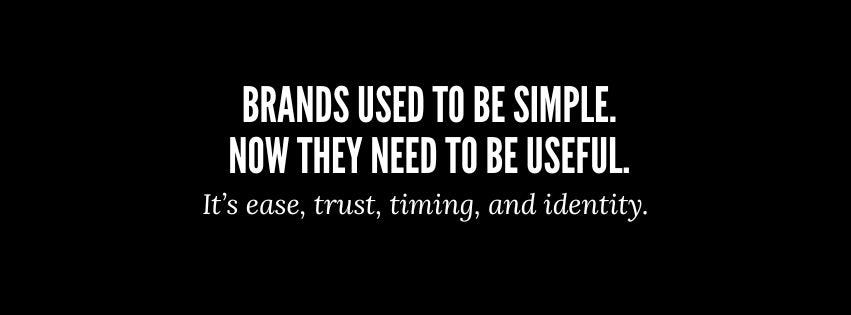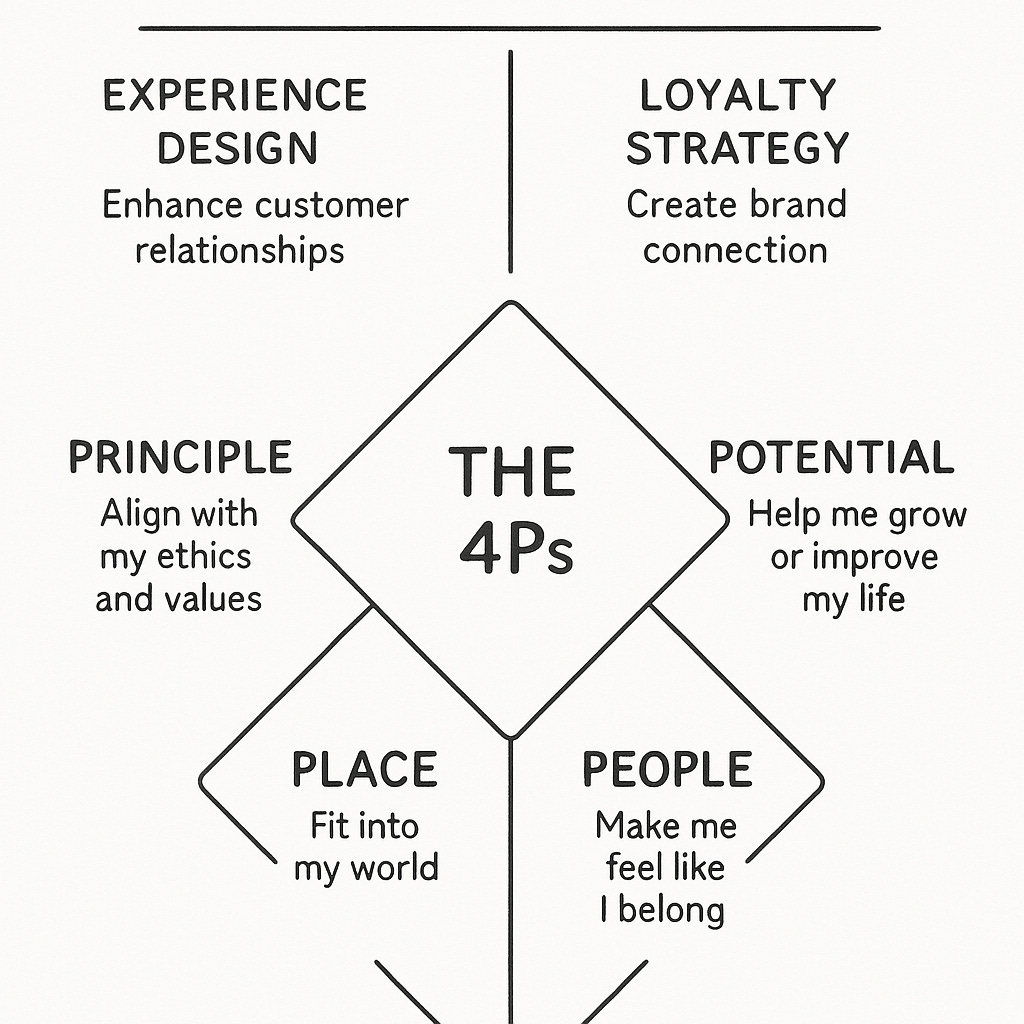Loyalty Without Love: A New Framework for Brand Strategy
Brands used to be simple. Now they need to be useful.
Building Brands for Identity, Time, Growth and Tribe
For most of the last century, brands were simple meaning machines—designed to reduce risk, reassure us of quality, and throw around some aspiration with our purchases. They helped us choose. In cluttered aisles, which was best, and was shorthand for good taste or insider status.
But it all depended on one thing: difference. In a world of differences and options, brands held the power.
Not anymore.
Everything has changed.
Digital has flattened those differences.
Platforms have multiplied the options.
AI is doing the comparing for us.
And suddenly, symbolic value isn't enough anymore. Consumers have stopped asking, "Do I like this brand?" and started asking, "What does it do for me right now?"
The Fundamental Shift in Brand Loyalty
Loyalty has transformed.
Less about love and more about fit—less emotional glue, more functional gravity.
Two weeks ago, I wrote about Why Your Customer Is Already Someone Else, and last week, Reshaping Loyalty and Brand Love.
These are two principles an experience strategist must consider.
And to build on that, here’s my loyalty model, which I’m giving you today.
Why It Matters
The brands winning aren't the ones shouting louder. They’re the ones doing more.
They're not chasing identity—they're enabling identity.
They're not promising meaning—they're delivering outcomes.
This is the new game.
I believe we should now be playing across four distinct dimensions:
Leading with Purpose, embedding shared values
Creating Progress, helping us grow and improve
Maintaining Presence, fitting into our lives naturally
Fostering Participation, creating shared experiences and community
My Relationship with Apple: It's Not Love
I don't love the brands I stick with.
Take Apple. I use my Mac, iPhone, and Apple Watch daily. Am I in love with Apple? No. I stay because Apple makes my life easier (and I’ll own up - I felt cool, originally). My devices sync up, and owning an i-something initially felt like being part of a creative, forward-thinking tribe—it's aspirational.
Apple's ads over the years didn't ask me to love them; they showed me how Apple products might inspire me and make me feel a bit "cool.” That keeps me loyal: engagement, aspiration, and an ecosystem that fits me, not some fuzzy feeling of brand love.
I'm not alone. Many brands winning loyalty that sticks aren't relying on pure emotion or affection. They are designed to fit identity and everyday relevance. They lock loyalty in by fitting into our lives or aspirations.
The Identity-Based Loyalty Model
It’s a clear pattern. Loyalty has shifted from being about our feelings toward a brand to being about the brand's role in our story.
Customers (though they don't articulate it in these words), ask a brand four very human questions to keep them in their lives:
"Does this brand share my values or identity?" (Is it in line with who I am?)
"Does this brand help me reach my goals or improve my life?" (Does it make me better or my life easier?)
"Does this brand fit my world and daily routines?" (Is it a natural part of my identity or lifestyle?)
"Does this brand make me feel like I belong to something?" (Do I connect with others through it?)
If a brand can check most, or all, of these boxes, we'll likely keep it around. Love isn't one of the checkboxes. It's about more practical and personal: alignment, usefulness, fit, and connection.
I call it "identity loyalty" – we are loyal to brands that align with us.
Consumorphosis: The Shapeshifting Consumer
In a world of consumorphosis, where consumers constantly morph their preferences and identities, loyalty is fluid and shifts to whatever fits our identity and context in the moment.
Sometimes I'm in task mode, so I want a brand to save me time and hassle; other times, I'm in tribe mode and looking for social connection; and at other times, I'm in growth mode, continuing my self-improvement.
Brands that can meet me in these modes, adapting to me, fitting into my world, when, they get my loyalty when the mode matches. I’m never loyal no matter what.
The 4P Framework of Modern Loyalty
Let’s name the four questions above—around alignment, usefulness, fit, and connection—the 4ps: Purpose, Progress, Presence, and Participation.
It’s a simple visual model for weaving your brand into the customer's identity, aspirations, routines, and relationships.
Brands used to matter because they reassured people—about safety, quality, performance, or just good taste—helping them navigate shelves and signal status. For most of the 20th century, brand value came from creating the right feelings and memories at the right moment. That worked when options were limited and attention was easy to buy. But now, consumers expect more.
They don't just want symbolic signals or stylised ads—they want real, personal value.
This is where the traditional playbooks and thinking break down.
The New Drivers of Loyalty
Loyalty today isn't driven by perception but by what a brand enables.
The new drivers are Purpose, Progress, Presence, and Participation.
Purpose is about aligning with someone's fluid identity and values—helping them stand for something.
Progress is about making their lives better—faster, smarter, more capable, more confident.
Presence is about being where it matters—in the right channel, moment, or mode.
Participation means letting people shape, co-create, or contribute, not just consume.
Culture and ‘code’ are the two levers making this possible.
On the culture side, brands will create value by helping consumers express who they are, connect with others, or support causes they care about—like Apple, Patagonia with climate activists, or Trader Joe's with its cult-like community.
On the ‘code’ side, it's about utility: Netflix curating moods, TikTok reading minds, Sephora teaching techniques, Peloton building skills, and Starbucks designing social space.
AI now takes this further, sensing what we want before we know it—reading intent, context, time, and habit. That unlocks a different kind of relevance: personal fit.
Moving Beyond the Love Paradigm
These brands earn loyalty by being useful, visible, empowering, and open.
It's no longer about how a brand looks or talks—it's about how it helps.
Giving people tools to express themselves, improve, connect with others, or simply get through their day a bit easier earns us a place in our customers’ regular rotation.
They won't write a sonnet about our brand, but they will buy from us, stick with us, and maybe advocate for us in far more concrete ways than a fleeting infatuation would inspire.
In a later newsletter, I'll explore the four Ps, exploring real-world examples of how some brands have mastered design for identity, time, connection, and changing modes. I'll also explain how brands that enable rather than enchant disrupt the loyalty game in today's fluid consumer landscape.
The strategies I'll unpack will change how you think about your brand's role in customers' lives—and why the quest for brand love might be holding you back.
There are many loyalty models around. It’s one of the more essential strategies in our new world, so I’d like to know what you think of mine. Let me know in the comments below.
Thank you for reading me.
Michael
I have a quick favour to ask you. You will probably have colleagues who aren’t subscribers but may be interested in this conversation. Please share this with them so we can broaden opinions.






Your Apple example nails it! The best loyalty is frictionless, not emotional. It's not about devotion; it's about engineering those micro-moments where sticking feels easier than switching. I just wrote about how Canva weaponizes this by making millions of users feel 'exclusive' during routine updates. The psychology is wildly fascinating.
I’m passionate about customer loyalty and just starting to share my observations here https://mariavonhope.substack.com/?r=5j9amn&utm_campaign=pub&utm_medium=web , hence I'd love to connect with you and others who think about this as detailed as you do!